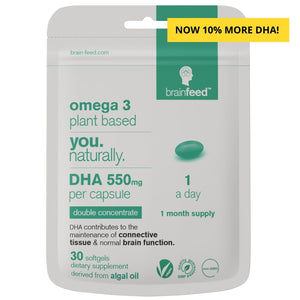Unveiling omega 3 benefits for the brain: the wonders of DHA for healthy adults
filter
DHA or Docosahexaenoic Acid, the key compound in omega -3 fats, has gained prominence for its remarkable impact on various aspects of well-being. This article delves into the compelling evidence that underlines the significance of DHA for healthy adults, omega 3 benefits for brain, cardiovascular wellness, inflammation regulation, vision support, and overall vitality.
DHA: what is it and how do you take it?
DHA is an essential omega 3 fatty acid that is a crucial component of the human diet and is primarily found in fatty fish, algae, and some dietary supplements. There are 1.4 grams of DHA in 100 grams of cooked wild Atlantic salmon[1]. DHA is known for its important role in supporting brain health and cognitive function. To benefit from DHA's brain-boosting properties and limit DHA side effects it's important to pay attention to the recommended daily dose[2]. So, how much DHA per day should you take? To reap the rewards of DHA, you should take 550mg of DHA daily[3]. brain feed developed a 550 mg DHA capsule which allows you to get the recommended omega 3 dosage for adults.
So, why do we need Omega 3?
Nourishing brain function
Cognitive function is a hallmark of vitality, and DHA's impact on brain health is both profound and promising. A study of 280 participants from the US found that higher DHA levels were associated with improved cognitive performance in healthy adults[4]. A study on 22 participants also showcased improved memory and attention in adults consuming higher DHA levels[5], aligning with the European Food Safety Authority's recognition of DHA's cognitive advantages which states “DHA contributes to the maintenance of normal brain function”[6].
Protection against ageing
DHA's neuroprotective properties are exemplified in a paper by Simon Dyall, a scientist with extensive experience with omega 3 and DHA research[7]. He reveals DHA’s ability to counteract mechanisms linked to cognitive decline during ageing such as inflammation & oxidative stress. Imagine DHA as a skilled orchestra conductor guiding a symphony performance played by different processes in the body. When inflammation and oxidative stress arise in the body it's like the orchestra is playing discordant notes. Just as the conductor guides musicians to play in harmony, DHA helps orchestrate anti-inflammatory and antioxidant responses. It ensures that the "musicians" work together seamlessly, creating a balanced and soothing melody.
More brain, more memory
DHA was shown to promote the growth of the message-receiving parts of neurons, the brain’s messengers, in the part of the brain responsible for memory[8]. An animal study has also shown that DHA promotes better brain communication by building better brain communication networks[9]. Picture DHA as the superhighway of communication within the brain, like a network of well-connected roads. Neurons are like cars travelling on these roads to deliver vital information. DHA is the high-quality pavement that ensures smooth and efficient travel for these neuron cars.
Long live the brain!
DHA's role in maintaining brain health as adults age. Research on 65 healthy older subjects found a connection between DHA and brain volume preservation, particularly in brain regions linked to memory and executive function[10]. Visualize the brain as a grand library filled with countless books, each representing knowledge and memories. Now, think of DHA as the architect and caretaker of this library. Just as an architect designs strong foundations and protective measures to preserve a building over time, DHA acts as the brain's architect, ensuring its structural integrity. These findings emphasize DHA's positive impact on cognitive longevity, as recognized by EFSA's standards.
Embrace DHA-rich dietary choices or consider supplementation when necessary, to take proactive steps toward nurturing your well-being. Let the evidence guide your choices, empowering you to embark on a path of wellness that celebrates the boundless potential of DHA for healthy adults.
References
[1] 200 Foods Highest in Docosahexaenoic Acid (DHA) (n.d.). My Food Data. https://tools.myfooddata.com/nutrient-ranking-tool/DHA/All/Highest/100g/Common/No
[2] Agostoni, C., Bresson, J. L., Fairweather Tait, S., Flynn, A., Golly, I., Korhonen, H., ... & Moseley, B. (2012). Scientific opinion on the tolerable upper intake level of eicosapentaenoic acid (EPA), docosahexaenoic acid (DHA) and docosapentaenoic acid (DPA): EFSA panel on dietetic products, nutrition, and allergies (NDA).
[3] Rafati, P., Hameed, M., Huang, X., & Isyaku, K. L. (2020). Review: The effect of DHA supplementation on the human health [Final Report]. University of Salford Manchester.
[4] Muldoon, M., Ryan, C., Sheu, L., Yao, J., Conklin, S., & Manuck, S. (2010). Serum Phospholipid Docosahexaenonic Acid Is Associated with Cognitive Functioning during Middle Adulthood. The Journal of Nutrition, 140, 848–853.
[5] Jackson, P. A., Reay, J. L., Scholey, A. B., & Kennedy, D. O. (2012). DHA-rich oil modulates the cerebral haemodynamic response to cognitive tasks in healthy young adults: A near IR spectroscopy pilot study. British Journal of Nutrition, 107(8), 1093–1098.
[6] EFSA (2011). Scientific Opinion on the substantiation of health claims related to docosahexaenoic acid (DHA), eicosapentaenoic acid (EPA) and brain, eye and nerve development (ID 501, 513, 540), maintenance of normal brain function (ID 497, 501, 510, 513, 519, 521, 534, 540, 688, 1323, 1360, 4294), maintenance of normal vision (ID 508, 510, 513, 519, 529, 540, 688, 2905, 4294), maintenance of normal cardiac function (ID 510, 688, 1360), “maternal health; pregnancy and nursing” (ID 514), “to fulfil increased omega-3 fatty acids need during pregnancy” (ID 539), “skin and digestive tract epithelial cells maintenance” (ID 525), enhancement of mood (ID 536), “membranes cell structure” (ID 4295), “anti-inflammatory action” (ID 4688) and maintenance of normal blood LDL-cholesterol concentrations (ID 4719) pursuant to Article 13(1) of Regulation (EC) No 1924/2006. EFSA Journal, 9(4), 2078–2108.
[7] Dyall, S. C. (2015). Long-chain omega-3 fatty acids and the brain: A review of the independent and shared effects of EPA, DPA and DHA. Frontiers in Aging Neuroscience, 7.
[8] Cao, D., Kevala, K., Kim, J., Moon, H.-S., Jun, S. B., Lovinger, D., & Kim, H.-Y. (2009). Docosahexaenoic acid promotes hippocampal neuronal development and synaptic function. Journal of Neurochemistry, 111(2), 510–521.
[9] Carbone, B. E., Abouleish, M., Watters, K. E., Vogel, S., Ribic, A., Schroeder, O. H.-U., Bader, B. M., & Biederer, T. (2020). Synaptic Connectivity and Cortical Maturation Are Promoted by the ω-3 Fatty Acid Docosahexaenoic Acid. Cerebral Cortex, 30(1), 226–240.
[10] Witte, A. V., Kerti, L., Hermannstädter, H. M., Fiebach, J. B., Schreiber, S. J., Schuchardt, J. P., Hahn, A., & Flöel, A. (2014). Long-Chain Omega-3 Fatty Acids Improve Brain Function and Structure in Older Adults. Cerebral Cortex, 24(11), 3059–3068.


 alertness
alertness
 cognition
cognition
 sleep
sleep
 wellbeing
wellbeing








Leave a comment
Open tab